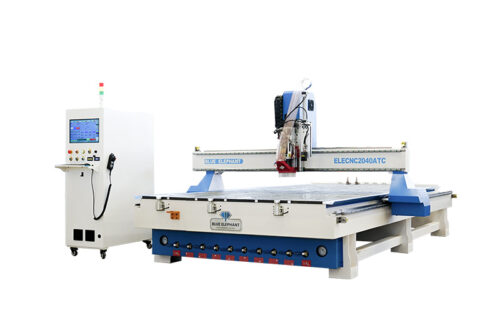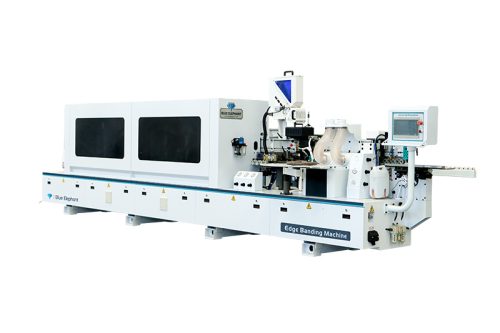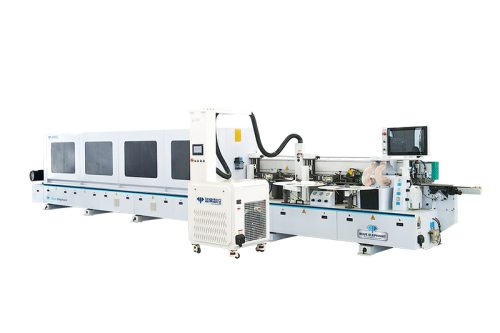You’ve got big plans. Custom furniture, detailed signage, maybe even a new product line. But before you can start, you’re stuck on a crucial decision: CNC router or laser cutter?
Pick the wrong one, and you could end up with rough cuts, burned edges, or a machine that simply doesn’t handle the materials you work with. I know, because I’ve been there.
As someone who’s spent years working with both CNC routers and laser cutters, I’ve seen people waste thousands on machines that weren’t suited for their business. You don’t have to make the same mistake.
In this guide, I’ll break down the real differences between CNC routers and laser cutters, including:
- What each machine excels at
- Which materials they can (and can’t) handle
- How to match the right tool to your business needs
By the end, you’ll have a clear answer so you can invest with confidence.
Let’s get started!
1. CNC Router vs Laser Cutter: Key Differences
When I first started looking for a cutting machine, I assumed they all worked the same way. A machine cuts a material. How different could they be? But once I started using them, I realized that CNC routers and laser cutters operate in completely different ways and produce very different results.
If you’re deciding between the two, understanding how they work is the first step.
How a CNC Router Works
A CNC (Computer Numerical Control) router is like a robotic carving tool. It uses rotating cutting bits to remove material from the surface. Imagine using a handheld router, but instead of guiding it by hand, a computer controls every movement.
- Moves in three or more directions (axes) to create detailed shapes and deep cuts.
- Can cut wood, plastics, foam, and soft metals like aluminum.
- Works best for carving, shaping, and creating strong joints.
CNC routers are common in furniture making, cabinet shops, and sign production because they can handle large, thick materials with ease.
How a Laser Cutter Works
A laser cutter doesn’t physically touch the material. Instead, it uses a high-powered laser beam to burn, melt, or vaporize the surface. Think of it like a magnifying glass focusing on sunlight, but way more precise.
- Cuts with incredible accuracy, making it great for fine details.
- Works best on thin materials like acrylic, leather, and plywood.
- Can engrave logos, patterns, and text without deep cuts.
If you need to make custom signs, jewelry, or intricate designs, a laser cutter is often the better choice.
So, which one is right for you?
Do you need deep cuts and strong joints, or are you looking for fine details and engraving? The right choice depends on what you’re making and what materials you work with.
Still unsure? Let’s break it down further.
2. Materials Each Machine Can Cut & Engrave
Choosing between a CNC router and a laser cutter isn’t just about how they work. The materials you plan to use can make or break your decision. Some projects require deep cuts through thick wood, while others need precise engravings on delicate surfaces.
So, which machine is better for your materials? Let’s break it down.
CNC Router Materials
A CNC router removes material using rotating bits, which makes it ideal for thicker and denser materials. If you’re building furniture, signs, or prototypes, this machine can handle heavy-duty work.
- Wood: MDF, plywood, hardwood, softwood
- Plastic: Acrylic, PVC, HDPE
- Metal: Aluminum, brass, copper, softer alloys (with proper tooling)
- Foam & Composites: EVA foam, carbon fiber panels, and similar materials
CNC routers work best when you need deep cuts, carved details, or sturdy joints.
Laser Cutter Materials
A laser cutter uses heat to melt, burn, or vaporize material, which makes it great for clean, precise cuts and detailed engravings.
- Wood: Best for engraving and thin sheets of plywood or MDF
- Acrylic & Plastics: Produces smooth, polished edges
- Paper, Fabric & Leather: Can cut and engrave without fraying or damaging the material
- Metal: Requires a fiber laser (CO2 lasers won’t cut metal effectively)
If you’re making custom signage, jewelry, or intricate designs, a laser cutter is often the better option.
So, which machine is right for you?
- If you need to cut thick, solid materials like hardwood or aluminum, a CNC router is the better option.
- If your projects involve engraving, intricate designs, or thin materials, a laser cutter is the way to go.
Think about what you’ll be making most often. Your material choice will determine which machine makes the most sense.

3. Precision & Cutting Quality
Have you ever ordered a custom sign or piece of furniture and noticed the edges weren’t quite right? Maybe they were a little rough, or the details didn’t look as sharp as they should.
That all comes down to cutting precision and not all machines handle it the same way.
If you’re deciding between a CNC router and a laser cutter, it’s important to understand how precise each one is and what kind of finish you can expect.
Cutting Accuracy
When it comes to precision, laser cutters have the upper hand.
Laser Cutter
- Can achieve accuracy down to ±0.01mm, which means almost no visible flaws.
- Produces smooth, clean edges with little to no extra finishing needed.
- Cuts by vaporizing material, so there’s no mechanical resistance that could cause shifting.
A CNC router, on the other hand, isn’t as precise.
CNC Router
- Accuracy typically falls around ±0.1mm or more which is fine for structural work but not ideal for intricate designs.
- Uses a rotating cutting bit, which can leave minor tool marks or rough edges.
- Requires sanding, polishing, or additional finishing to get a smooth result.
If you need to cut precise patterns, logos, or fine engravings, a laser cutter is the better choice. If your project requires strong joints, deep cuts, or large-scale shaping, a CNC router makes more sense.
Edge Finish & Detailing
Think about the kind of finish you want.
Do you need crisp, polished edges or deep, sculpted cuts?
Laser Cutter
- Best for delicate engraving, intricate patterns, and detailed lettering.
- Works well on thin materials where smooth edges are important.
- Leaves a slightly burnt edge on wood, which some people like for aesthetic purposes.
CNC Router
- Great for 3D carving, furniture-making, and structural pieces.
- Cuts deep into wood, plastic, and metal, creating strong joints and durable parts.
- Requires post-processing (like sanding) for a clean finish.
If smooth edges and precision engraving are your priority, go with a laser cutter. If you need depth and durability, a CNC router is the better tool.
Both machines are great. It just depends on what you’re building.

4. Ease of Use & Learning Curve
Buying a machine is one thing. Learning how to use it? That’s a whole different challenge.
Some machines take hours or even days to set up. Others need special software, constant maintenance, or a steep learning curve that can leave beginners feeling frustrated.
So, how easy is it to get started with a CNC router or a laser cutter?
Setup & Software
One of the biggest differences between these two machines is how you design and prepare your cuts.
CNC Router
- Requires CAM (Computer-Aided Manufacturing) software to generate toolpaths.
- Setup can be tricky, you need to choose the right cutting bits, speeds, and feeds.
- Some routers use manual zeroing, meaning you have to align everything perfectly before starting a job.
I remember my first CNC router project. The software asked me to set toolpaths, adjust cutting depths, and pick the right speed.
I had no clue what I was doing.
After a lot of trial and error (and some ruined material), I finally got it right.
Laser Cutter
- Uses vector-based design software like CorelDRAW, Adobe Illustrator, or LightBurn.
- Much easier for beginners, just upload a design, adjust settings, and hit start.
- No need to worry about tool changes or cutting depth.
If you’re new to CNC machines, laser cutters are much easier to start with. CNC routers take longer to learn but offer more flexibility for deep cuts and shaping.
Maintenance & Upkeep
Every machine requires maintenance, but how much work are you willing to put in?
CNC Router
- Cutting bits wear down and need frequent replacements.
- Produces dust and debris, requiring a dust collection system.
- Moving parts need lubrication and regular cleaning.
Laser Cutter
- CO2 lasers degrade over time, tubes need replacing every 6-12 months.
- Lenses and mirrors must be cleaned regularly to prevent weak laser output.
- Requires proper ventilation to remove smoke and fumes.
If you prefer low-maintenance, a laser cutter might be the better fit. But if you don’t mind changing bits and dealing with dust, a CNC router offers more versatility for cutting thicker materials.
At the end of the day, it’s all about what you’re comfortable handling.
Are you looking for simplicity, or do you want full control over your cutting process?
5. Cost Comparison
Buying a machine isn’t just about the price tag.
It’s also about long-term costs—maintenance, energy use, and the extra parts you’ll need over time. Some machines are cheaper upfront but cost more to run. Others require a bigger investment but have lower upkeep.
Before you invest, let’s break down what you can expect to spend.
Initial Investment
Buying a machine isn’t just about getting the cheapest option. You need the right machine for your workload, materials, and long-term goals.
CNC Routers
- Entry-level models start at $1,000 – $5,000. These are good for hobbyists and small businesses.
- Industrial-grade routers can cost $10,000 or more, depending on size, spindle power, and automation features.
Laser Cutters
- CO2 laser cutters start at $500 – $3,000. These work well for small businesses, signage, and crafts.
- Industrial fiber lasers can exceed $20,000, especially if they’re designed for metal cutting.
If you’re on a tight budget, a basic CO2 laser cutter is the most affordable option. But if you need to cut thicker materials, a CNC router might be worth the extra investment.
Ongoing Costs
Upfront price is just one part of the equation. How much will it cost to keep your machine running?
CNC Router
- Router bits wear out and need replacements. Higher-quality bits last longer but cost more.
- Consumes more electricity than laser cutters, especially on long cuts.
- Requires a dust collection system, which adds to the cost.
Laser Cutter
- CO2 laser tubes degrade over time and typically need replacing every 6-12 months.
- Air assist and ventilation systems are necessary to clear smoke and prevent overheating.
- If cutting metal, fiber laser parts can be expensive to replace.
Which machine is more cost-effective? It depends on what you’re making.
If you work with thick materials, CNC routers offer durability but require more maintenance. If you need fine engraving and smooth cuts, laser cutters are easier to maintain but have higher part replacement costs.
Think beyond the purchase price.
Long-term costs can impact your business just as much as the initial investment.
6. Speed & Production Efficiency
Time is money.
Whether you’re making furniture, custom signs, or intricate engravings, speed matters.
The faster your machine can complete a job without sacrificing quality, the more products you can create—and the more profit you can make.
But not all speed is the same. Some machines are faster for deep cuts, while others shine when working on fine details. So, which machine gets the job done quicker?
CNC Router
CNC routers are built for strength, not speed. They take longer on intricate details but remove material efficiently when cutting deep or shaping large pieces.
- Works well for batch production of furniture, cabinetry, and large signs.
- Can cut thicker materials in a single pass, making it ideal for structural components.
- Slower for engraving and fine detailing, since the cutting bit must physically move over every section.
I once saw a furniture maker use a CNC router to carve out 30 chair legs in a single run. It took a while to set up, but once started, the machine did all the work.
For mass production, CNC routers shine.
Laser Cutter
Laser cutters work fast, especially on fine details. Since they cut without physical contact, they can move at high speeds without resistance.
- Ideal for logos, nameplates, and arts & crafts projects.
- Can engrave text, patterns, and designs in minutes, even on delicate materials.
- Works best for thin materials, since thick cuts take multiple passes.
If you run a custom engraving business or make personalized products, a laser cutter will get jobs done faster than a CNC router.
Which one is more efficient? It depends.
- If you need deep cuts, shaping, or mass production, go with a CNC router.
- If you want fast engraving and fine details, a laser cutter is the better option.
The right choice comes down to what you’re making and how quickly you need it done.

7. Which Machine is Best for Your Business?
By now, you’ve seen how CNC routers and laser cutters differ in cutting style, speed, and material compatibility. But how do you decide which one is best for your business?
Think about what you make, what materials you use, and how much precision you need.
Each machine has strengths that make it better suited for different industries.
Choose a CNC Router if you:
- Work with thicker materials like wood, plastic, or soft metals.
- Need 3D carving for furniture, mold making, or sign production.
- Run a cabinet shop, woodworking business, or metal fabrication shop.
- Want a machine that can handle large-scale, high-volume projects.
Choose a Laser Cutter if you:
- Work with thin materials like acrylic, leather, or coated metals.
- Need fine engraving for personalized gifts, signage, or jewelry.
- Run a customization business that sells intricate designs.
- Want a cleaner cutting process with minimal dust and maintenance.
There’s no “one-size-fits-all” machine.
The best choice is the one that matches your business needs, materials, and production goals.
What are you making? Answer that, and the decision becomes much easier.
8. Common Mistakes When Choosing Between a CNC Router & Laser Cutter
Buying the wrong machine is an expensive mistake. I’ve seen people spend thousands on a machine, only to realize it doesn’t fit their needs. Maybe they thought a laser cutter could cut through thick wood, or they expected a CNC router to engrave intricate designs with perfect precision.
Before you invest, let’s go over some common mistakes so you don’t make them.
Mistake #1: Assuming a Laser Cutter Can Cut Thick Materials
Some buyers assume a laser cutter can handle thick wood, metal, or plastic with ease. While fiber lasers can cut metal, standard CO2 lasers struggle with thick materials.
- A laser cutter works best on thin materials like acrylic, fabric, or plywood.
- If you need deep cuts in hardwood or aluminum, a CNC router is the better tool.
I once watched someone try to cut a two-inch hardwood slab with a laser cutter. It took multiple passes, burned the edges, and still didn’t go through. A CNC router would have finished the job in minutes.
Mistake #2: Expecting a CNC Router to Engrave Like a Laser
CNC routers are great for carving and shaping, but they don’t offer the same fine detail as a laser cutter.
- A laser cutter engraves with precision down to ±0.01mm.
- A CNC router uses a rotating bit, which leaves tool marks and requires sanding.
If you need sharp lettering, logos, or photo engravings, go with a laser cutter.
Mistake #3: Forgetting About Maintenance Costs
Both machines require upkeep, but in different ways.
CNC Routers:
- Bits wear out and need frequent replacement.
- Generate a lot of dust, requiring a dust collection system.
Laser Cutters:
- Laser tubes need replacing every 6-12 months (for CO2 models).
- Lenses and mirrors must be cleaned regularly to maintain cutting power.
Ignoring maintenance can slow production and cost you more in the long run.
Before buying, think about your materials, your designs, and the long-term costs. A little research now can save you time, money, and frustration later.
Conclusion
We’ve explored the key differences between CNC routers and laser cutters, helping you understand which fits your business.
But, the question isn’t which machine is better. It’s which one is better for YOU.
What do you build? What features matter most in your workflow?
Your answer will lead you to the right choice.
And if you still have questions, contact us today. We’re here to help!












